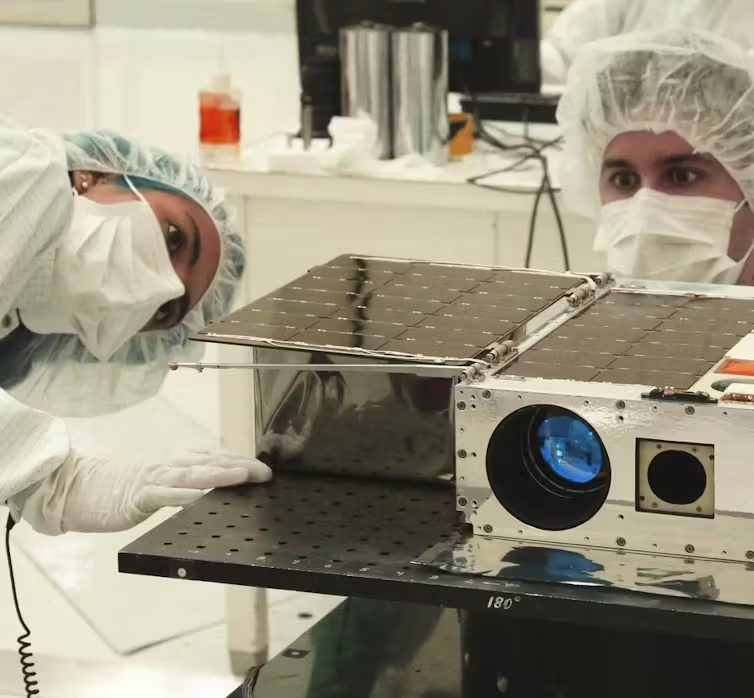
Cubesats, the tiniest of satellites, are changing the way we explore the solar system
Whether discovering exoplanets or measuring the size of an asteroid, cubesats are affordable throughout the space community, even to small startup, private companies and university laboratories.

Most cubesats weigh less than a bowling ball, and some are small enough to hold in your hand. But the impact these instruments are having on space exploration is gigantic. Cubesats — miniature, agile and cheap satellites — are revolutionizing how scientists study the cosmos.
A standard-size cubesat is tiny, about 4 pounds (roughly 2 kilograms). Some are larger, maybe four times the standard size, but others are no more than a pound.
As a professor of electrical and computer engineering who works with new space technologies, I can tell you that cubesats are a simpler and far less costly way to reach other worlds.
Rather than carry many instruments with a vast array of purposes, these Lilliputian-size satellites typically focus on a single, specific scientific goal — whether discovering exoplanets or measuring the size of an asteroid. They are affordable throughout the space community, even to small startup, private companies and university laboratories.
Related: Cubesats: Tiny, versatile spacecraft explained (infographic)
Tiny satellites, big advantages
Cubesats’ advantages over larger satellites are significant. Cubesats are cheaper to develop and test. The savings of time and money means more frequent and diverse missions along with less risk. That alone increases the pace of discovery and space exploration.
Cubesats don’t travel under their own power. Instead, they hitch a ride; they become part of the payload of a larger spacecraft. Stuffed into containers, they’re ejected into space by a spring mechanism attached to their dispensers. Once in space, they power on. Cubesats usually conclude their missions by burning up as they enter the atmosphere after their orbits slowly decay.
Breaking space news, the latest updates on rocket launches, skywatching events and more!
Case in point: A team of students at Brown University built a cubesat in under 18 months for less than US$10,000. The satellite, about the size of a loaf of bread and developed to study the growing problem of space debris, was deployed off a SpaceX rocket in May 2022.
Smaller size, single purpose
Sending a satellite into space is nothing new, of course. The Soviet Union launched Sputnik 1 into Earth orbit back in 1957. Today, about 10,000 active satellites are out there, and nearly all are engaged in communications, navigation, military defense, tech development or Earth studies. Only a few — less than 3% — are exploring space.
That is now changing. Satellites large and small are rapidly becoming the backbone of space research. These spacecrafts can now travel long distances to study planets and stars, places where human explorations or robot landings are costly, risky or simply impossible with the current technology.
But the cost of building and launching traditional satellites is considerable. NASA’s lunar reconnaissance orbiter, launched in 2009, is roughly the size of a minivan and cost close to $600 million. The Mars Reconnaissance Orbiter, with a wingspan the length of a school bus, cost more than $700 million. The European Space Agency’s solar orbiter, a 4,000-pound (1,800-kilogram) probe designed to study the Sun, cost $1.5 billion. And the Europa Clipper — the length of a basketball court and scheduled to launch in October 2024 to the Jupiter moon Europa — will ultimately cost $5 billion.
These satellites, relatively large and stunningly complex, are vulnerable to potential failures, a not uncommon occurrence. In the blink of an eye, years of work and hundreds of millions of dollars could be lost in space.
Exploring the moon, Mars and the Milky Way
Because they are so small, cubesats can be released in large numbers in a single launch, further reducing costs. Deploying them in batches – known as constellations — means multiple devices can make observations of the same phenomena.
For example, as part of the Artemis 1 mission in November 2022, NASA launched 10 cubesats. The satellites are now trying to detect and map water on the moon. These findings are crucial, not only for the upcoming Artemis missions but to the quest to sustain a permanent human presence on the lunar surface. The cubesats cost $13 million.
The MarCO cubesats — two of them — accompanied NASA’s Insight lander to Mars in 2018. They served as a real-time communications relay back to Earth during Insight’s entry, descent and landing on the Martian surface. As a bonus, they captured pictures of the planet with wide-angle cameras. They cost about $20 million.
Cubesats have also studied nearby stars and exoplanets, which are worlds outside the solar system. In 2017, NASA’s Jet Propulsion Laboratory deployed ASTERIA, a cubesat that observed 55 Cancri e, also known as Janssen, an exoplanet eight times larger than Earth, orbiting a star 41 light years away from us. In reconfirming the existence of that faraway world, ASTERIA became the smallest space instrument ever to detect an exoplanet.
Two more notable cubesat space missions are on the way: HERA, scheduled to launch in October 2024, will deploy the European Space Agency’s first deep-space cubesats to visit the Didymos asteroid system, which orbits between Mars and Jupiter in the asteroid belt.
And the M-Argo satellite, with a launch planned for 2025, will study the shape, mass and surface minerals of a soon-to-be-named asteroid. The size of a suitcase, M-Argo will be the smallest cubesat to perform its own independent mission in interplanetary space.
The swift progress and substantial investments already made in cubesat missions could help make humans a multiplanetary species. But that journey will be a long one – and depends on the next generation of scientists to develop this dream.

Mustafa Aksoy joined the faculty of the Department of Electrical and Computer Engineering in Fall 2017. Dr. Aksoy received his Ph.D. in Electrical and Computer Engineering in 2015 from the Ohio State University, where he worked as a graduate research associate at the ElectroScience Laboratory. Prior to joining the University at Albany, Dr. Aksoy was a post-doctoral research associate at the University of Maryland Baltimore County and NASA Goddard Space Flight Center. His research interests include microwave passive remote sensing of Earth and Space and electromagnetic theory. Dr. Aksoy has been the sole-investigator of several projects supported by NASA, NSF and ORAU, published more than 60 peer-reviewed journal and conference articles, and received NSF Faculty Early Career Development Program, NASA Space Technology Mission Directorate Early Career Faculty, NASA Robert H. Goddard Exceptional Achievement for Engineering, and ORAU Ralph E. Powe Junior Faculty Enhancement awards.
Dr. Aksoy is a senior member of the Institute of Electrical and Electronics Engineers (IEEE), the IEEE Geoscience and Remote Sensing Society (GRSS), and the IEEE Geoscience and Remote Sensing Society’s Frequency Allocations in Remote Sensing (FARS) Committee.


